Posted on: 16.09.2020
How to deliver impactful and measurable Digital PR: Hosted by Hanson Search and Threepipe Reply
On Wednesday 9th September, Hanson Search and Threepipe Reply hosted a panel event to share tips and tricks for building effective digital PR strategies to improve clients’ reputations and visibility among target audiences.
As PR departments come under greater scrutiny to better prove ROI, many are pivoting to adopt a more SEO-led approach when it comes to shaping content campaigns and measuring online impact.
On this webinar, Hanson Search CEO Alice Weightman was joined by Threepipe Reply’s Head of PR, Sophie Lennon, and Associate Director, Jessica Shanks to talk through link outreach strategies and how creative and technology can work together to deliver improved results. The presentation was followed by a panel discussion, with Sophie Lennon, Vix Leyton, and Gino Romagnuolo on the merits and challenges of digital PR achieving high domain authority backlinks.
Alice Weightman, CEO, Hanson Search
Featuring our expert panel:
- Sophie Lennon, Head of PR, Threepipe Reply
- Jess Shanks, Associate Director, Threepipe Reply
- Vix Leyton, Head of PR, carwow
- Gino Romagnuolo, SEO Director at Threepipe Reply
What is Digital PR? A presentation from Sophie Lennon & Jess Shanks
SL: What is PR? It’s all about raising awareness of a brand by getting people to talk about it. It used to be about hosting events at really ‘cool’ places with really ‘cool’ things, partnering with ‘cool’ people, stopping people from saying ‘uncool’ things and generating a buzz around a new product by putting it on ‘cool’ pages.
PR today is largely the same, with a hefty dose of reality and a new shiny toy. I think we all remember the many, many brands floating things down the Thames. You can’t do that anymore unless you can do it on a website. You can’t really do pop-ups anymore either unless you can do it on a website. And no more AVE, thank goodness, we have search rank now.
We still have press offices, influencers, and reputation management. We just have a new-ish shiny phrase.
So what is digital PR?
Honestly it is just PR. We’ve been doing it for years and years, but until recently we didn’t count the links that we often achieved accidentally. Digital PR is where PRs add a link KPI to their KPI set. It’s about adding link building within a KPI and making PR commercially work. We now need to generate and count the links we’ve secured and, more importantly, know when to ask for a link and when to leave it alone.
Why do we do it?
For awareness. It’s about securing high domain authority (DA) links. DA is really key when it comes to links. We do this to improve our search rank position which in turn is raising awareness. A bit like influencers in 2012.
JS: Has anyone ever tried asking a journalist for a link? The most common answer is ‘No’, which is a problem. All our clients and brands are desperate for us to get more links, so the solution for us is to create something that has a clear consumer benefit and most importantly only ask for a link when it’s relevant. We don’t want to get link apathy.
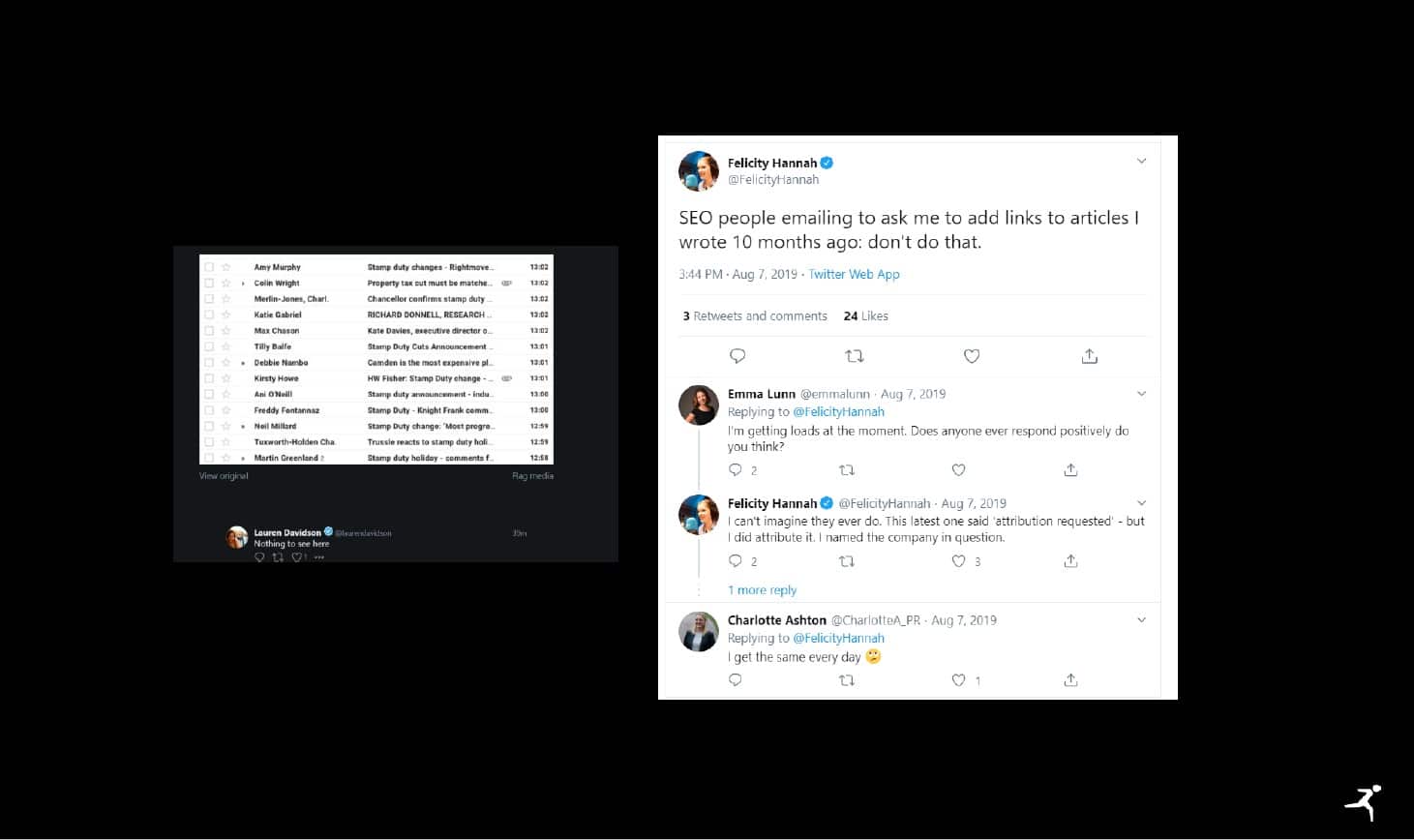
In digital PR, we often have to make very boring things interesting. This means we flit between peril and fascination. Consumers don’t click on links to find out something they a) already know or b) don’t find scary. For us, particularly in this Covid world, it’s about treading this difficult line.
For example, instead of stating the fact, ‘people are buying more green energy’, you could say, ‘did you know that green energy often isn’t actually green energy? Find out how eco-friendly you really are here’.
The key to digital PR is to avoid apathy. If you feel like you’re tying yourself up in knots while trying to persuade a journalist to give you a link, you probably are, and they will see you. Build a digital press office that is 80% press office and 20% campaign with a reason to link. It’s important that you don’t arm wrestle yourself into these conversations because you are building long-term relationships.
SL: It’s all about making the right people link to the right content. So you have to target carefully. It’s not just about having a press office, you also have to have a campaign-led approach.
DA70+ is usually a national; DA40+ sites are your best bet when it comes to securing good links. If you come across a client who says that as a KPI they want 50 links, DA70+ in month one, be very wary. That is somewhat of an impossible task.
Interestingly, the regionals do really good linking and as a result get really good search ranking for your clients – especially the catalyst regionals. For example, The Scotsman ran a story for us that included a link to a website tool we had built with the client. That one placement generated 150+ links of DA40+.
Know your competition
Knowing your competition is really important. As PR professionals, we strategise for our clients; that is what we are paid to do and that’s what we have to do. We need to look for the gaps.
The key to success in digital PR is being different and giving the reader something relevant. You have to do your research from the outset. You have to audit competitors and you have to go back through the years. With a really interesting piece of content, they won’t re-do it, so you have to know what’s been done already. Don’t use the same experts as your competitors, don’t copy assets, and always use original supporting data.
Find the links to your competition. Which of your competitors are being linked, but not to you? Find them, pitch them a story, give them a reason to link to you. Remember, quality is better than quantity. More outreach does not always mean quality backlinks.
The value of partnerships
JS: This isn’t new, we just have to be a bit more strategic about how we work with partners. Many media titles have paid partnerships, providing links to website tools that appear in editorial sections. With paid for links counting towards page rank, these are worth considering. They can also block competitor links – an added benefit!
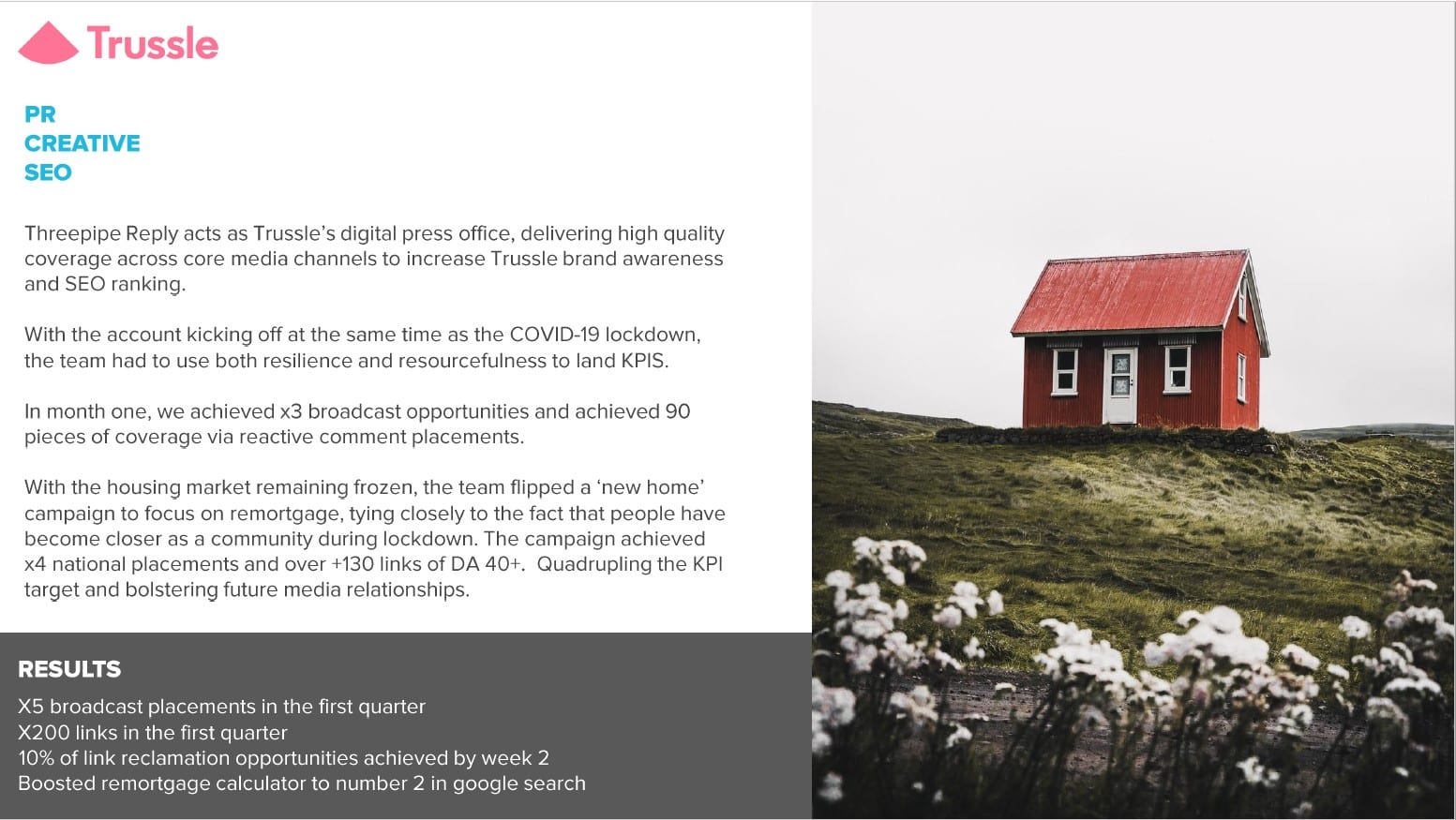
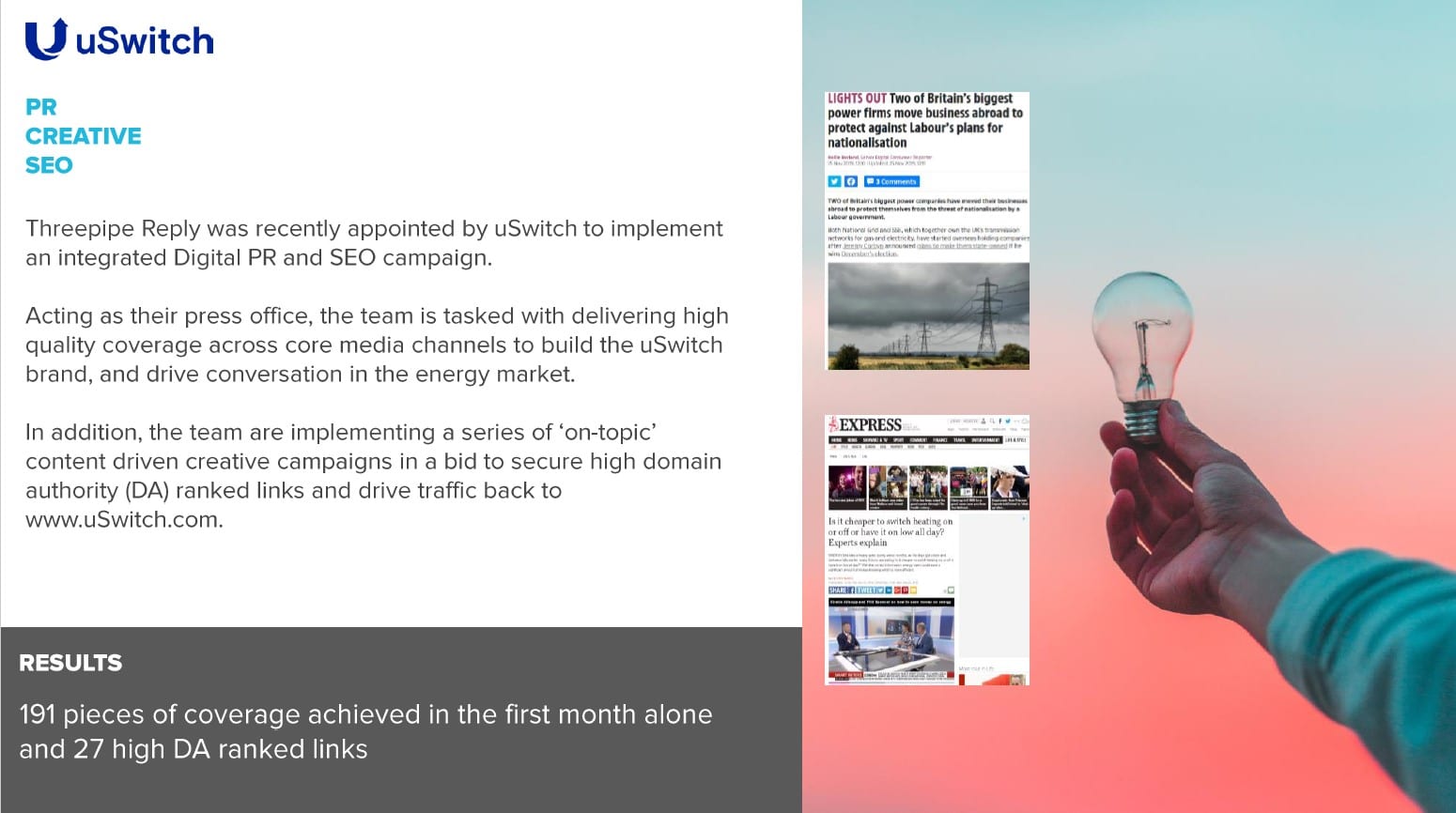
SL: In summary, PR is and always will be evolving. There is always something new. Digital PR is really what we are seeing happening at the moment and we’re finding great tactics to get it right. It’s not easy, but it is good fun and there are lots of opportunities.
Panel Q&A with Sophie Lennon, Vix Leyton and Gino Romagnuolo
Q1. Has digital PR taken over from traditional PR?
VL: It’s less a takeover and more an evolution. It’s something I noticed early on; I was an early adopter and hitching my wagon to SEO because it’s measurable and as a PR person I can show a business that result. A lot of the problems with traditional PR results were that people didn’t really believe them. Whereas with digital PR, you can prove if you got a link back or if you improved Google rankings. That was the magic dust that people wanted to hear.
It’s gone a bit far in some businesses though; I’ve seen some business that think the whole role of PR is now link-building. You could do a ton of great coverage but if your SEO coverage says that none of them have link-backs then they will say that you’ve not done your job.
I still get excited about print coverage, if it’s good. My dream is still a front page story. But I accept now that a high DA, really relevant site that maybe none of the people in my business see has just as much value.
I think the future is working together – traditional and digital. I’ve found that since I stopped worrying about digital PR coming in and stealing my space and the work that I’ve done, I’ve become better by proxy.
New things are always going to be greeted with suspicion, especially when there is a very established ‘old’ way of doing things, but digital is a way of embedding ourselves more into the marketing mix and improving the value of what we can do.
Q2. Are you finding that clients are coming to you saying, ‘I’m looking for a digital or traditional PR solution’ or are you guiding them?
SL: It’s a bit of both. What we like to do is get a briefing and then strategise alongside the client. It’s all dependent on what they want to achieve. Often they work together. We get briefs that come through asking specifically for a digital PR agency but when we drill down what they really want is online coverage.
The most popular briefs I’ve received this year have been a combination of digital and brand awareness and that’s why we combine press offices and campaign. We’re also talking to our incumbent clients about how to do more digital PR within their briefs because people are seeing the results and what it does.
Q3. Stripping it back to basics, I’m sure some people are confused about the difference between digital PR, SEO, content, product, etc. What is the relationship between these areas?
GR: That’s an interesting question. SEO, content, and digital PR are basically the same thing, but approached from different angles. SEO is more data-driven, while PR is probably more creative. By working together, it’s much better because we can help PR make their content more unique and data-driven while they can take our dry content and make it more creative and engaging. This approach allows us to work together more and deliver better campaigns to clients.
Q4. How has digital PR helped improve reputation and moved the dial amongst the professional stakeholder audience, for example, investors or politicians?
SL: We’ve often worked with companies who have investors that are looking at what’s happening with the reputation – Trussle is one of them. That’s the one where we built the digital PR calculator, a tool to showcase the savings when it comes to re-mortgages. The number of hits we achieved and the fact that it went to number two in search rankings meant that they were able to see the direct results coming from our work. That’s what those sorts of people are looking at and measuring at the moment.
What’s important to note here is that it does take time. You won’t see the impact quickly – it doesn’t happen overnight. It’s often a combination of two or three campaigns as they build on one another.
VL: I agree. We built an electric charging point tool because we really wanted to be known for electric. We looked at what was on the market and other people’s electric charging point maps and they were pretty static so we thought we’d build one that’s better and give people the capability to rate the charging points when they get there.
Initially, we got about two pieces of coverage on it which was not ideal when you’ve made a product, built something specifically for the website. But we reference it in every electric piece we do, because of the political landscape around electric cars and the targets for 2035. Every time we do a comment on electric, we mention this tool, and now the tool itself has started getting coverage months later. If we’d gone off that first month, it would have looked like a massive flop. That’s one of the differences between digital PR and traditional, a lot of it is slow burn.
Transferwise is another good example to look at. They campaigned and lobbied to get transfer fees canceled, built a little microsite within their website and asked people to sign up and download a template that they could send to their local politicians. They managed to get that so far with so much investment that they changed the law. That started probably as a nice little CRM exercise to get email addresses, but actually in the end they impacted the law and it was a massive PR win for them. From a brand point of view it was brilliant, from a traffic point of view it was a hit, and they built a whole public affairs team out of it.
Q5. How important are these interactive tools and can they come up in different types of ways?
SL: It can be expensive. The way we do it is build the tools internally. We have a team that does that. But sometimes it’s easier for the client to build it themselves – using what they have and their knowledge. That’s another reason we don’t build these tools every few weeks; it’s about having a clear, proactive strategy sitting alongside your reactive strategy.
We’re often tasked with thinking of a tool that has longevity, for instance, can it come back next Christmas or pivot to do something else. A good PR agency will get you value for money. I would say you shouldn’t need more than two or three tools per year. Then keep going back to them.
Q6. How do you ensure positive overlap between digital PR and affiliate schemes?
SL: They are very different. There are paid partnerships as well as smaller affiliates. It’s really about who you’re reaching and who you’re trying to target. They don’t always run together but they can if you have the right objectives for both.
We sometimes do paid partnerships but it limits you. As a PR agency, we’re always looking for mass coverage and the best results so we concentrate more on that side. We tend to look at them more on their own.
VL: I used to work at Quidco and we did some great partnerships with the Mirror, where it was PR led. We did a Cream Egg one on the recipe of Cream Eggs. We knew the cost of a new member so we told new members that they could get six Cream Eggs for free if you signed up for Quidco and we put an affiliate link in that. That was more like a little PR overlay to get direct response.
There is a risk though that as soon as you do a paid partnership with a paper all your links then become affiliate links and then you’ve cut off one of your opportunities so it’s a hard line to walk. It depends what your product is.
Q7. Aside from annoying journalists with link requests, what are some other pitfalls that people should avoid in digital PR?
SL: People often now take to social media to explain their dissatisfaction with PR people asking for links. You’ve got to know your audience, know your journalist. It’s really simple. If you want to do digital PR well, you need to prep the same way you would in traditional PR. Do your research and know who you are contacting and whether your request is relevant.
Another pitfall I would mention on the client side is unrealistic expectations. You’re probably not going to get 50 links back in your first month. You’ve got to have a really good client-agency relationship, which obviously starts the moment you start your campaign, but you’ve got to be realistic about your expectations and you’ve got to be prepared to pivot.
GR: One of the biggest pitfalls from my perspective is a lack of collaboration between SEO and digital PR. Another one is patience – if you lack the patience to wait for the results, you might take the wrong decision. Give the campaign enough time to produce results before you make a change.
Q8. How do businesses/brands evaluate success and what tools could you recommend?
GR: It depends what angle you are coming from. Rankings and organic visibility are one of the biggest ‘wow’ measurements that you can give to your client, but in general, what we like to do is consider some indirect measurements, like brand searches and brand uplift as well as number of links and domain authority. Of course, we want to improve rankings and visibility, mainly for unbranded terms which are the most competitive, but it is important to look at how much brand awareness is growing as well.
VL: One thing I like to feedback on as well is relevancy because it’s important that the links you’re building do some of the work. I build that into a bespoke spreadsheet at the end of the month alongside all of the traditional metrics. Relevancy is a biggie because you’ll see agencies come to you with an idea off the shelf that will get links but it won’t necessarily do the job that they want it to do beyond getting links. And that’s where SEO and PR can really work together.
Q9. How do you make sure that the SEO and PR team are working together from a day to day, practical point of view?
GR: That’s something we do case by case depending on the brief. You might need an SEO/digital PR collaboration or an SEO/content collaboration. We take a step by step approach, so step one would be data digging and general SEO checks, for instance, you can create a brilliant SEO content piece but if that content isn’t going to be indexed it’s basically a waste of time. We want to be sure that the site is in good shape from an SEO perspective.
Then what we do from a content side is provide indication on data, so what search volumes are on certain topics, that way we can come up with original ideas around those topics. Then we might do surveys to base new content on original stats. We tend to provide the tech and data, while the PR team will then come up with the content around the topics.
SL: What Geo isn’t saying is that we also sit right behind and we’re talking to him all the time! We are constantly talking, but you could do that with an outside SEO team as well, it’s about having clear points of control and who’s responsible for what, and then collaboration and partnerships are what you need to get successful PR campaigns. Working with an SEO agency is the same as working with a client. The more often you talk to people, the better.
Q10: How do you select an agency to work with?
VL: The last time I selected an agency, I worked with our head of SEO which was hugely beneficial because he was able to ask questions that I wouldn’t have even thought of and similarly I was able to ask questions for him. We called it a content marketing agency rather than a PR agency. We wrote the brief together and looked at the shortlisted sites that we found, basically by Googling digital PR agencies.
Look at their case studies and the way they measure results. Don’t feel like you necessarily have to put a price on it because it might be worth having those conversations to find out what you actually need long-term. It is a big investment. If you can afford to start small and then scale up, do that, because then you can fail fast. And get the right buy-in from all of your stakeholders.
SL: From an agency side, it’s great having all the talent under one roof. I love that collaboration that comes internally to be able to do the best job. We obviously have Gino’s team, we have a creative team, and we also have a social team. I think you need all of these things, one way or another, they all work well and that’s how you’ll get the best results.
If you find an agency that’s prepared to challenge your brief and whether your expectations or desired outcomes marry up with what you’re asking for in that brief, that’s what you want. You don’t want an agency that’s going to take your money and run. You want an agency that’s going to give you honest feedback on your brief, and maybe that means sending you to another team.

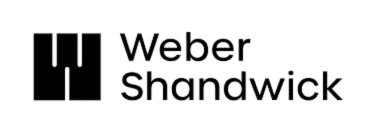





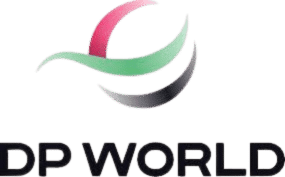



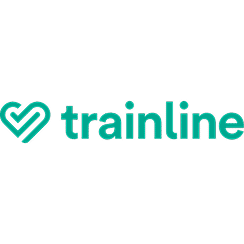

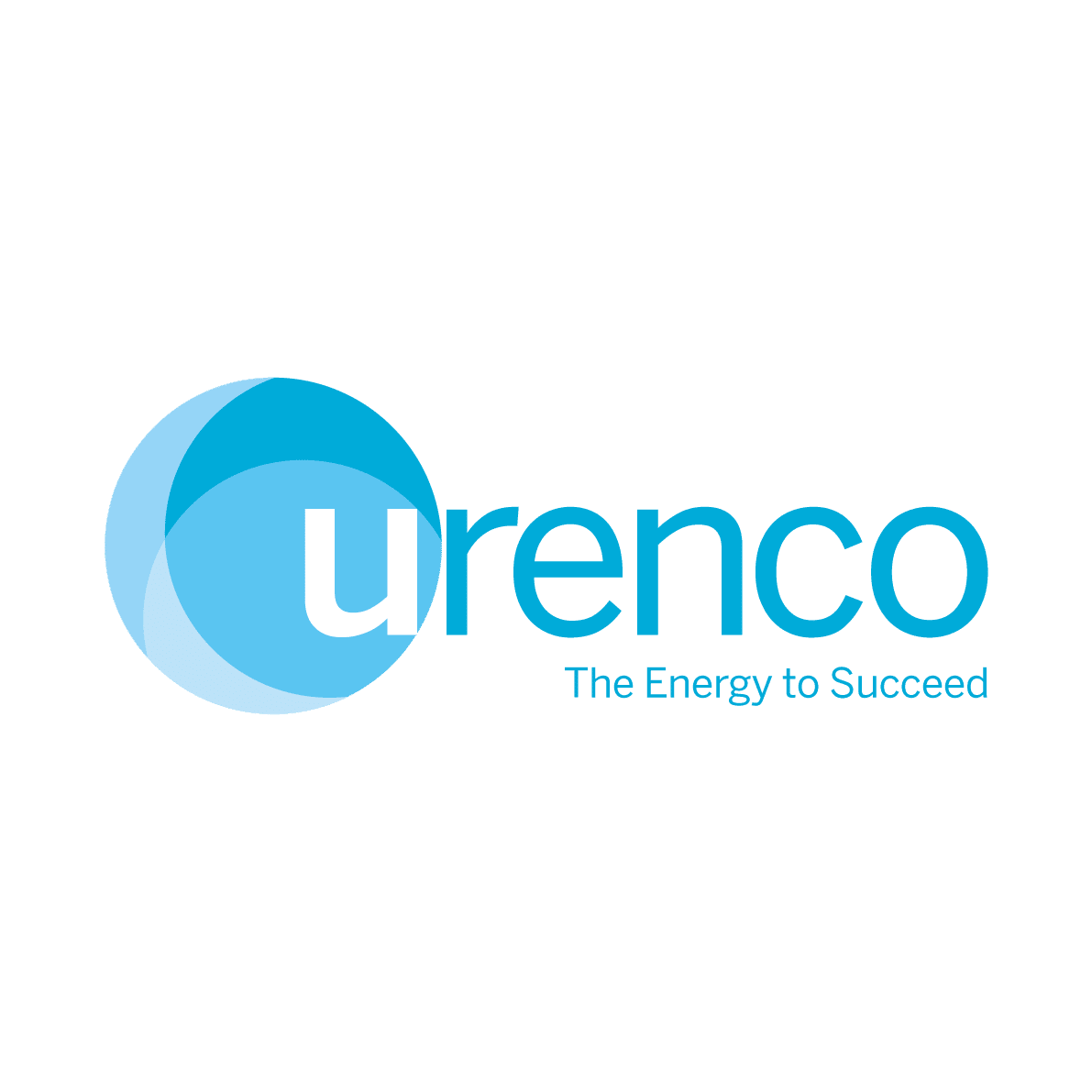
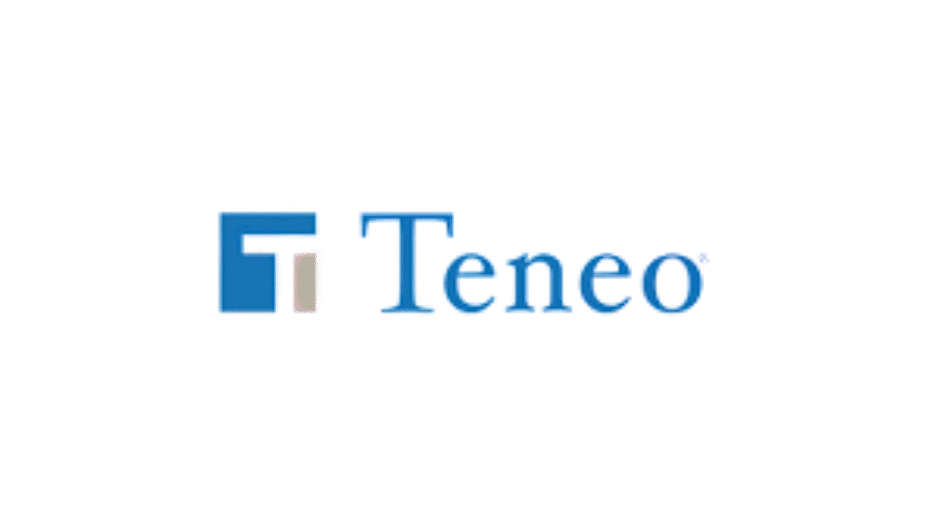




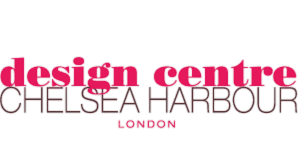


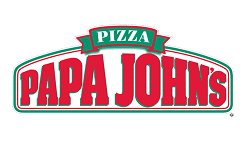



 Career Enquiry
Career Enquiry
